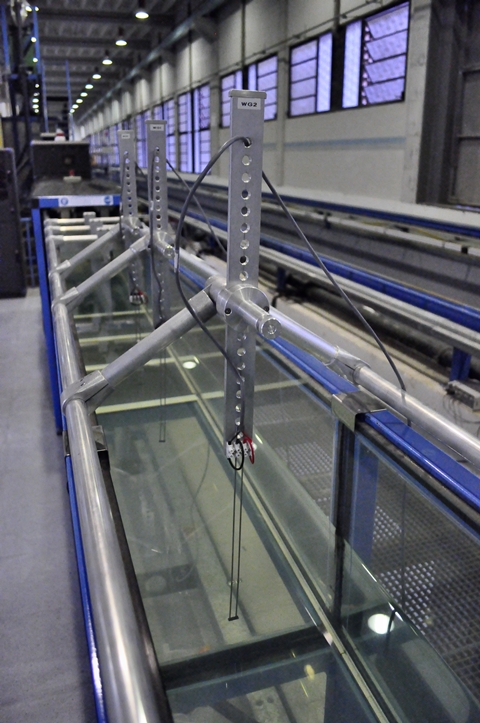CIEMito
The idea of building the small-scale wave flume CIEMito emerged with the goal of creating a tool capable of providing quality support for teaching and research in the field of marine and coastal engineering, and become for their special characteristics, the perfect complement to the large-scale wave flume CIEM. Thus CIEMito has become part of the experimental infrastructures within the CiemLab inside the Laboratori d’Enginyeria Marítima (LIM) from the Universitat Politècnica de Catalunya (UPC).
Also the design and development of CIEMito, conducted entirely in the LIM, has been an interesting technical challenge which has turned the knowledge and experience in the CIEM use in the past 15 years.
A flume of the small size of CIEMito makes its operation easier, and maximizes typology test variability and its use, all while minimizing costs, compared to the needs of a flume of larger dimensions, while not belittling the quality of the results.
At the constructive level CIEMito has a total length of 18m, with a useful section of 0.38m wide and 0.56m high and a maximum water depth of 0.36m. The support structure consists of square section metal sections and both laterals and bottom walls are of tempered glass 5 +5 mm thick.
Also the design and development of CIEMito, conducted entirely in the LIM, has been an interesting technical challenge which has turned the knowledge and experience in the CIEM use in the past 15 years.
A flume of the small size of CIEMito makes its operation easier, and maximizes typology test variability and its use, all while minimizing costs, compared to the needs of a flume of larger dimensions, while not belittling the quality of the results.
At the constructive level CIEMito has a total length of 18m, with a useful section of 0.38m wide and 0.56m high and a maximum water depth of 0.36m. The support structure consists of square section metal sections and both laterals and bottom walls are of tempered glass 5 +5 mm thick.

For ease of operation at both ends are arranged wells of 0.20m in diameter, which allows both filling and emptying and controlled recirculation of water through the current generation system. Also has a 3m3 tank and a pumping system and filter itself to maintain its autonomy from use of other facilities.
The wave generation is conducted using a piston-type board, whose motion is provided by a linear actuator 1m maximum stroke and speed of response 1.6m/s. The maximum theoretical capacity to a depth of 0.36m corresponds to a wave period and 1.7s of 0.28m in height. Generation software used has been developed at LIM / UPC and allows the generation of regular and irregular waves and time series reproduction.
The data acquisition system is based on a combined PXI-SCXI expandable device from National Instruments with an actual capacity of 32 analog channels. A standard software acquisition is conducted using the acquisition and analysis package Wavelab developed by the Aalborg University.
The currently available instrumentation pool consists in 8 resistive wave probe HRWallingford, 8 Microsonic acoustic level sensors and 2 industrial 2Mpix IDS cameras for tests measurements and documentation.
The wave generation is conducted using a piston-type board, whose motion is provided by a linear actuator 1m maximum stroke and speed of response 1.6m/s. The maximum theoretical capacity to a depth of 0.36m corresponds to a wave period and 1.7s of 0.28m in height. Generation software used has been developed at LIM / UPC and allows the generation of regular and irregular waves and time series reproduction.
The data acquisition system is based on a combined PXI-SCXI expandable device from National Instruments with an actual capacity of 32 analog channels. A standard software acquisition is conducted using the acquisition and analysis package Wavelab developed by the Aalborg University.
The currently available instrumentation pool consists in 8 resistive wave probe HRWallingford, 8 Microsonic acoustic level sensors and 2 industrial 2Mpix IDS cameras for tests measurements and documentation.






Share: